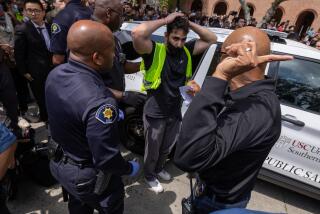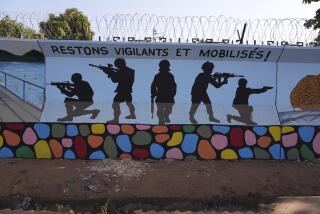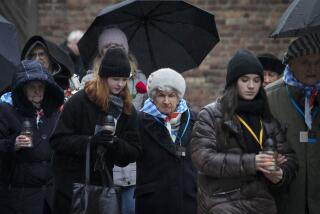Massacre, Cremation of 3,000 in Bosnia Detailed : Balkans: Serbs at 2 camps killed up to 50 Muslims at a time and burned the bodies, State Dept. now believes.
WASHINGTON — Ultranationalist Serbs were killing Muslims in Bosnia at the rate of up to 50 at a time, then secretly cremating their bodies at night and disposing of them in a rendering plant, according to eyewitness reports that the State Department now accepts as credible.
Senior U.S. officials confirmed Saturday that the State Department last week for the first time obtained graphic, first-person accounts corroborating a massacre of about 3,000 people last May in two Serbian detention camps operated at a brick factory and a pig farm near the Bosnian town of Brcko, about 75 miles north of Sarajevo.
“This could have been happening in other places too,” one State Department official said Saturday. He said he doubts that such massacres are continuing today, “given the exposure that has taken place since August.”
The State Department’s reports, obtained by American diplomats, essentially corroborate and give further details to a story first reported in early August, when the Long Island newspaper Newsday published eyewitness accounts of prisoners who had been released from Serbian detention camps at Brcko and Omarska in Bosnia-Herzegovina.
The Brcko killings were carried out under the direction of ultranationalist Serb leaders known as Vojislav Seselj and as Arkan (who uses only one name), a senior State Department official said. These new reports provided the basis under which acting Secretary of State Lawrence S. Eagleburger urged the United Nations last week to set up a commission to investigate war crimes in Bosnia.
“We want to move it as fast as we can,” Eagleburger said of the war-crimes resolution.
Although the Bush Administration has supported the use of force to deliver humanitarian aid in Bosnia, it has so far avoided calling for military intervention to try to bring about peace or to safeguard Bosnian Muslims. The United States is now talking with its allies about the possibility of setting up a “no-fly” zone that would prevent Serb forces or those of the Serbian-dominated rump Yugoslav federation from staging air strikes in Bosnia.
After the initial press reports of a Brcko massacre, a 53-year-old man from there named Alija Luginovic came to Washington and gave his account before a closed session of the Senate Armed Services Committee. He described how more than 1,000 captives of a detention camp had been slaughtered by Serb guards.
A State Department official said that last week, American diplomats interviewed a number of former prisoners of the camps at Brcko. On the basis of those interviews, he said, it is apparent that the number of people killed was higher than Luginovic had estimated.
“Many people were killed, in groups of up to 50 at a time,” the State Department official said. “A total of about 3,000 people--men, women and children--were killed in the camps at Brcko.” He said at least some of the prisoners were beaten and tortured before they were killed.
One of the former prisoners at the camp told U.S. officials that “he several times had to transfer dead people to an animal rendering plant, where they secretly cremated bodies at night to evade detection,” according to a senior State Department official.
The two worst detention camps were said to have been at a brick factory and a pig farm in the Brcko area. It was here that the State Department believes most of the killing took place.
Last August, soon after the initial reports of a massacre, Serbian officials in Bosnia denied any wrongdoing. At one point, they conducted Western reporters on a trip to Brcko, insisting that there were no detention camps in or around the city.
However, some Serbian officials later acknowledged that thousands of prisoners were shuttled from one place in Bosnia to another in an effort to prevent Western human rights officials and journalists from finding detention camps.
In Sarajevo on Saturday, peace envoys Cyrus R. Vance, representing the United Nations, and Lord Owen, representing the European Community, said that they have gathered clear evidence that Bosnian Muslims have been forced from their homes by Serbs and attacked as they fled.
Owen said that he and Vance heard eyewitness accounts of “systematic shelling” of 3,000 to 4,000 Muslim refugees who were driven from the northern Bosnian town of Banja Luka after being stripped of money and possessions, according to the Associated Press.
“There were casualties, and some people lost their lives,” Owen said. “There is no question that this sort of thing cannot be allowed to go on.” He did not give a specific casualty figure.
Owen is a former British foreign secretary, and Vance is a former U.S. secretary of state. Together they are chairing peace talks in Geneva on what used to be Yugoslavia.
The massacre at Brcko was apparently part of a policy of so-called “ethnic cleansing,” the practice of forcing one ethnic group from an area to strengthen another group’s claims to it.
All sides in Bosnia’s civil war have been accused of the practice, but foreign officials put most of the blame on the Serbs, who have captured two-thirds of the republic since its Muslim-Croat majority voted for independence from Serb-dominated Yugoslavia on Feb. 29.
More than 10,000 have died in the fighting. The Health Ministry said Saturday that the casualty toll in the past 24 hours was 54 killed and 285 wounded throughout Bosnia, including 21 killed and 104 wounded in the capital.
More to Read
Sign up for Essential California
The most important California stories and recommendations in your inbox every morning.
You may occasionally receive promotional content from the Los Angeles Times.










